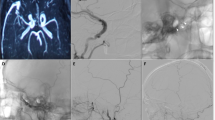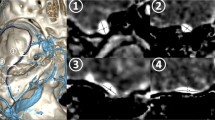Abstract
Purpose
The standard approach of midline suboccipital craniectomy entails sacrifice of the Occipito—marginal sinus. We have attempted to preserve this venous channel by using a durotomy technique which preserves this system. In a pilot study initiative, two groups of patients using this technique versus the standard approach, were compared in terms of per and post operative benefits, morbidity and complications. The literature with reference to the anatomy and venous flow dynamics of the occipital and marginal sinuses and their significance has been reviewed. Similarly, literature regarding dural closure technique with reference to postoperative complications has also been reviewed.
Methods
In this novel approach, the dura is opened as a crescent to avoid damage to the occipital sinus. This technique was compared with the standard midline dural opening technique by random usage of both techniques in 24 patients.
Results
The ‘crescent’ approach has been found to reduce the need for duroplasty, with comfortable primary closure and to reduce the risk of postoperative pseudomeningocele.
Conclusions
This is a novel dural opening technique which attempts to preserve the normal venous flow physiology. In essence it helps in increased primary dural closures and reduction of Pseudomeningiocele/CSF leak as well as blood loss and venous hypertension.



Similar content being viewed by others
References
Alperin N, Lee SH, Sivaramakrishnan A, Hushek SG (2005) Quantifying the effect of posture on intracranial physiology in humans by MRI flow studies. J Magn Reson Imaging 22:591–596
Ayanzen RH, Bird CR, Keller PJ, McCully FJ, Theobald MR, Heiserman JE (2000) Cerebral MR venography: normal anatomy and potential diagnostic pitfalls. AJNR Am J Neuroradiol 21(1):74–78
Balak N, Ersoy G, Uslu Ü, Tanriöver N, Tapul L, Çetin G, Işik N, Elmaci I (2010) Microsurgical and histomorphometric study of the occipital sinus: quantitative measurements using a novel approach of stereology. Clin Anat 23:386–393
Castro ME, Portnoy HD, Maesaka J (1991) Elevated cortical venous pressure in hydrocephalus. Neurosurgery 29(2):232–238
Dora F, Zileli T (1980) Common variations of the lateral and occipital sinuses at the confluens sinuum. Neuroradiology 20(1):23–27
Falk D (1986) Evolution of cranial blood drainage in hominids: enlarged occipital/marginal sinuses and emissary foramina. Am J Phys Anthropol 70(3):311–324
Fukai J, Uematsu Y, Shintani A, Nakai K, Itakura T (2002) Intraoperative hemorrhage in medulloblastoma: a case report and review of the literature. Child’s Nerv Syst 18:356–360
Gisolf J, van Lieshout JJ, van Heusden K, Pott F, Stok WJ, Karemaker JM (2004) Human cerebral venous outflow pathway depends on posture and central venous pressure. J Physiol 560(Pt 1):317–327
Gnanalingham KK, Lafuente J, Thompson D, Harkness W, Hayward R (2003) MRI study of the natural history and risk factors for pseudomeningocoele formation following postfossa surgery in children. Br J Neurosurg 17(6):530–536
Gnanalingham KK, Lafuente J, Thompson D, Harkness W, Hayward R (2002) Surgical procedures for posterior fossa tumors in children: does craniotomy lead to fewer complications than craniectomy? J Neurosurg 97(4):821–826
Greitz D, Hannerz J (1996) A proposed model of cerebrospinal fluid circulation: observations with radionuclide cisternography. AJNR Am J Neuroradiol 17(3):431–438
Hamnett NTJ, Ogungbo B, Nahser H, Javadpour M (2010) Anomalous cerebral venous sinus drainage. Br J Neurosurg 24(4):497–498
Rollins N, Booth T, Shapiro K (2000) MR venography in children with complex craniosynostosis. Pediatr Neurosurg 32:308–315
San Millán Ruíz D, Gailloud P, Rüfenacht DA, Delavelle J, Henry F, Fasel JH (2002) The craniocervical venous system in relation to cerebral venous drainage. AJNR Am J Neuroradiol 23(9):1500–1508
Schreiber SJ, Lurtzing F, Gotze R, Doepp F, Klingebiel R, Valdueza JM (2003) Extrajugular pathways of human cerebral venous blood drainage assessed by duplex ultrasound. J Appl Physiol 94(5):1802–1805
Steinbok P, Singhal A, Mills J, Cochrane DD, Price AV (2007) Cerebrospinal fluid (CSF) leak and pseudomeningocele formation after posterior fossa tumor resection in children: a retrospective analysis. Childs Nerv Syst 23(2):171–174
Tanoue S, Kiyosue H, Sagara Y, Hori Y, Okahara M, Kashiwagi J, Mori H (2010) Venous structures at the craniocervical junction: anatomical variations evaluated by multidetector row CT. Br J Radiol 83(994):831–840
Tubbs RS, Ammar K, Liechty P, Wellons JC 3rd, Blount JP, Salter EG, Oakes WJ (2006) The marginal sinus. J Neurosurg 104(3):429–431
Widjaja E, Griffiths PD (2004) Intracranial MR venography in children:normal anatomy and variations. Am J Neuroradiol 25:1557–1562
Williams H (2008) A unifying hypothesis for hydrocephalus, Chiari malformation, syringomyelia, anencephaly and spina bifida. Cerebrospinal Fluid Res 5:7
Zamboni P, Consorti G, Galeotti R, Gianesini S, Menegatti E, Tacconi G, Carinci F (2009) Venous collateral circulation of the extracranial cerebrospinal outflow routes. Curr Neurovasc Res 6(3):204–212
Conflicts of interest
None.
Author information
Authors and Affiliations
Corresponding author
Rights and permissions
About this article
Cite this article
Panigrahi, M., Krishnan, S.S. & Varma, D.R. Crescent posterior fossa durotomy for occipito-marginal venous sinus preservation: A pilot study. Acta Neurochir 154, 2115–2121 (2012). https://doi.org/10.1007/s00701-012-1457-3
Received:
Accepted:
Published:
Issue Date:
DOI: https://doi.org/10.1007/s00701-012-1457-3




